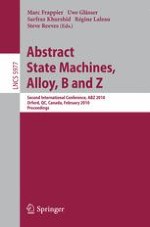2010 | Book
Abstract State Machines, Alloy, B and Z
Second International Conference, ABZ 2010, Orford, QC, Canada, February 22-25, 2010. Proceedings
Editors: Marc Frappier, Uwe Glässer, Sarfraz Khurshid, Régine Laleau, Steve Reeves
Publisher: Springer Berlin Heidelberg
Book Series : Lecture Notes in Computer Science
